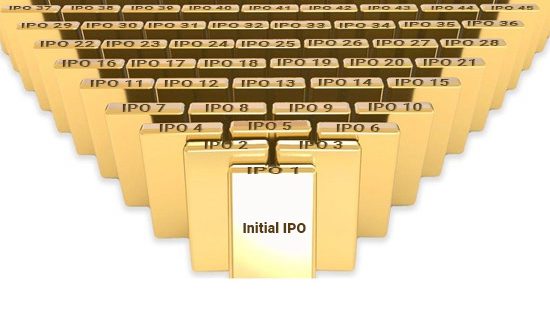Problem – Corporate Situation

A corporation needs equity financing and has sufficient time to make its Initial Public Offering,
but, it does not have enough capital to pay for the expenses necessary to setup and organize said IPO, which include:
Legal advice, accounting, audit, financial public relations, advertising, medias, press, infographics, roadshows, hotels and representation etc…
Solution: Initial Public Offering Issue
Initial Public Offering of Equity Securities Issue abbreviated Initial Public Offering or IPO


- An IPO is under the regulation by the Securities and Exchange Commission (SEC) and requires strict financial reporting criteria on a regular basis to remain available for trade by investors.
- In an oferta pública inicial, the issuer obtains the assistance of an underwriting firm to help determine what type of security to issue, the best offering price, the number of shares to be issued, and the time to bring it to market.
- Although the underwriting firms such as Goldman Sachs (GS) or Morgan Stanley (MS) that bring the issue to market hold shares to sell to their clients at the initial sales price, average investors can obtain the shares once they begin trading in the secondary market. IPOs can be a risky bet for investors, as there is no previous market activity to evaluate. This is why reading the IPO prospectus report, and gaining any knowledge about the company is crucial before investing.
- IPOs became friendlier to small businesses as a result of the passage of the Jumpstart Our Business Startups Act, which was created to support hiring and lessen the otherwise extensive financial reporting burden on small businesses filing for an IPO.
Solution: Initial Public Offering Issue

Following the model of a construction loan to a corporation, the Initial Public Offering Funding works the same way:
- Financier submits to an Investor a proposal to finance the costs of organization of an Initial Public Offering Issue project by an Issuer and its budget.
- Investor approves the Issuer and said Initial Public Offering Issue and budget and invests an amount to pay for the cost of organization of said Initial Public Offering Issue Transaction, but does not remit the funds to corporation.
- Corporation submits payments of the suppliers to Financier who pays suppliers directly.
Investor’s Remuneration per IPO
Cash upon IPO
| Item | % | $ |
|---|---|---|
| Commission | 6% | Max USD 60M Min USD 6M |
Equity Participation Value upon IPO
| Item | % | $ |
|---|---|---|
| Participation on Newly Issued Shares |
6% | Max USD 300M Min USD 10M |
Risk

- Delays of procedure by the Securities & Exchange Commission for reasons due to procedure novelty or to Issuer’s situation
- Insolvent or poorly funded Issuer’s misrepresentation blocking the IPO.
- Pandemic era blocking the IPO process.
- Recession should not block the IPO process but can affect Issuer’s valuation but the impact on Investor’s profitability would be light.




